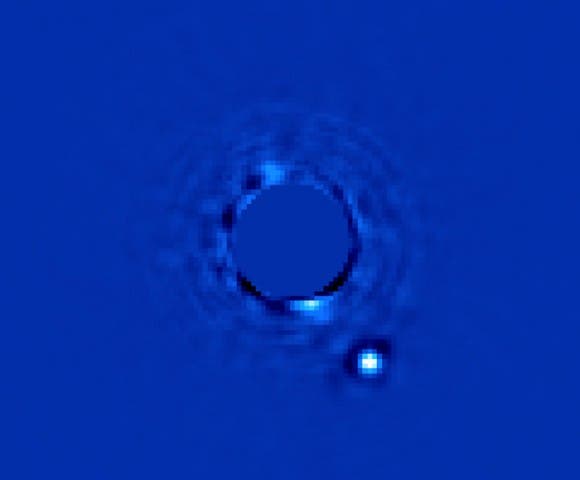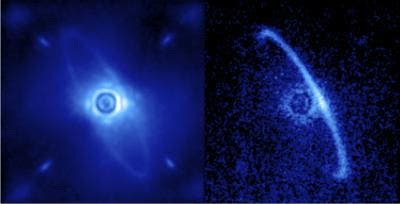
The bright star Beta Pictoris is hidden behind a mask in the center of the images; a few scattered starlight artifacts, called ‘speckles,’ are also visible, but vastly fewer than in previous images. Beta Pictoris b is a giant planet – several times larger than Jupiter – and is approximately ten million years old. These near-infrared images (1.5-1.8 microns) show the planet glowing in infrared light from the heat released in its formation. GPI image credit: Image processing by Christian Marois, NRC Canada.
In the past few decades planet hunters have confirmed a couple hundred alien planets, with hundreds more on the waiting list. Think about it, hundreds or thousands of light years away a myriad of alien planets exist, maybe some similar to our very own Earth, which scientists are ferociously studying. There many technical limitations however. Most of these planets – called exoplanets – were discovered and confirmed using indirect methods, and only a handful have been imaged directly. This is about to change was with the full-blown deployment of a new high-tech imaging instrument mounted on the 8-meter Gemini South telescope in Chile.
After years or development and testing, the world’s most advanced instrument for directly imaging planets outside our solar system finally delivered its first photos. The Gemini Planet Imager (GPI), as it’s called, didn’t disappoint as early first-light images are almost a factor of 10 better than the previous generation of instruments. In one minute, we are seeing planets that used to take us an hour to detect. One such planet is the famous Beta Pictoris b, orbiting the star Beta Pictoris. Center image is the star, while the bright pixels on the right hand side shows the planet. It might not seem like much, but after you realize the planet’s 63 light-years away and several times more massive — as well as 60% larger — than Jupiter a whole new level of appreciation unfolds.
“Most planets that we know about to date are only known because of indirect methods that tell us a planet is there, a bit about its orbit and mass, but not much else,” said Bruce Macintosh of the Lawrence Livermore National Laboratory, who led the team that built the instrument. “With GPI we directly image planets around stars – it’s a bit like being able to dissect the system and really dive into the planet’s atmospheric makeup and characteristics.”
Despite its large size, Beta Pictoris b is a very young planet — estimated at being less than 10 million years old (the star itself is only about 12 million.
The GPI is truly a marvel of modern technology. Since it’s deployed on a ground telescope, its biggest enemy keeping it from rending accurate images of planets light years away is our own atmosphere. Clever engineers went away with atmospheric turbulence by devising a system that senses and corrects it with a 2-centimeter-square deformable mirror with 4,000 actuators. The new mirror corrects for atmospheric distortions by adjusting its shape 1,000 times per second with accuracy better than 1 nanometer. Together with the other parts of GPI, astronomers can directly image extra-solar planets that are 1 million to 10 million times fainter than their host stars.

The left image (1.9-2.1 microns) shows normal light, including both the dust ring and the residual light from the central star scattered by turbulence in the Earth’s atmosphere. The right image shows only polarized light. Leftover starlight is unpolarized and hence removed from this image. The light from the front edge of the disk is strongly polarized as it scatters towards us.
Image credit: Processing by Marshall Perrin, Space Telescope Science Institute
Besides Beta Pictoris, the Gemini researchers also tested other features of the instrument like the polarization mode, where the telescope can detected light scattered by tiny particles. Pictured below is an image taken by GPI featuring a very young star, HR4796A , surrounded by a faint ring of dust. With previous instruments, only the edges of this dust ring (which may be the debris remaining from planet formation) could be seen, but with GPI, astronomers can observe the entire circumference of the ring.
The GPI will be fully booked for year as it’s slated to survey more than 600 exoplanets. The few findings we’ve been served to so far are dazzling, and one can only wonder what the people at Gemini will find next. As always, ZME Science will keep you posted.









